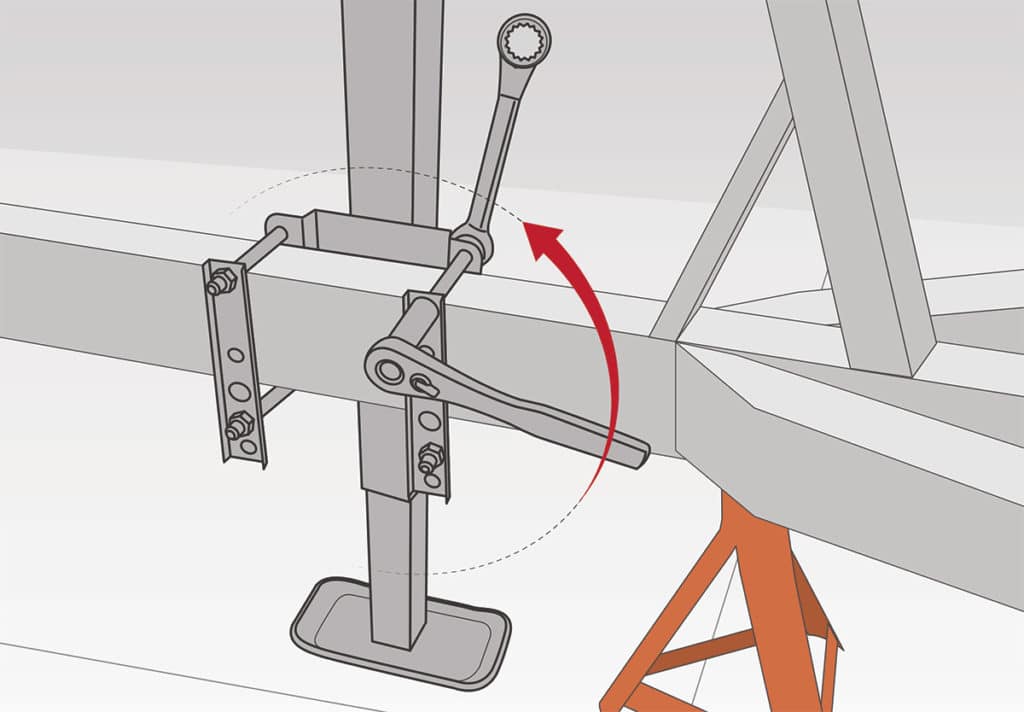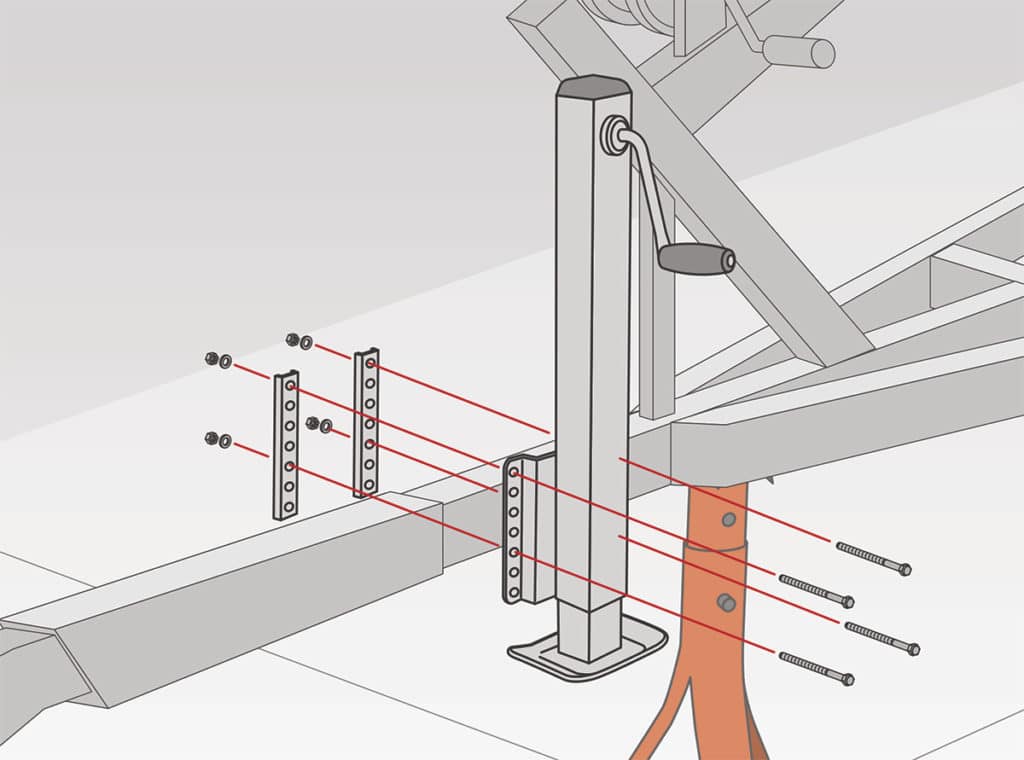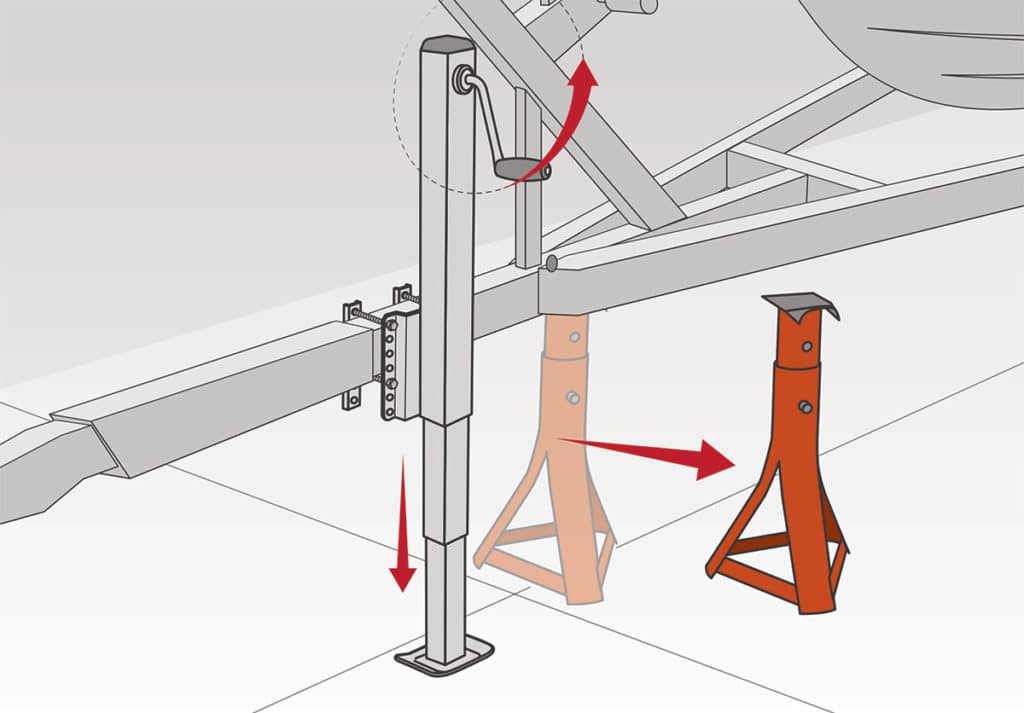
I go through a heavy-duty trailer tongue jack every three to four years. Corrosion, frequent use, and a hefty boat and trailer take a toll on these jacks, so I have become adept at changing them out. It can be tricky, especially if the jack gives out in the “up” position while the trailer is hitched to a tow vehicle.
Gears break, telescoping arms lock up from rust, and pivoting mechanisms come apart. Sometimes the jack gets broken when boaters forget to raise it after they hitch up the trailer; it drags on the pavement and becomes damaged.
Whatever the cause, you can replace the jack immediately, using the vehicle to support the trailer tongue while you carry out the work, but few boat owners have spare tongue jacks just sitting around. That leaves you wondering how to raise and support a heavy trailer to unhook the boat so you can use your vehicle for other purposes, such as shopping for a new jack. Here are the steps I use when this situation arises, using a Fulton 2,500-pound square-tube jack.
Getting Started
Skill Level: 1.5/5
Time to Complete: 1 Hour
Tools and Supplies
* Fulton 2,500-pound square-tube tongue jack ($78.99, anchorexpress.com)
* Floor jack
* 6-by-6-inch wood blocks
* Jack stands
* 3-by-3-foot sheet of ½-inch plywood
* Box/open-end wrench set
* C clip pliers ($15.99, acehardware.com)
* Reciprocating saw (to cut off rusted bolts)
* Safety glasses
* Marine grease

1. Use a Floor Jack
If the tongue jack goes kaput while the trailer is hitched to a tow vehicle, don’t stress. Park the boat and trailer in their storage location and chock the tires. Use a sufficiently rated hydraulic floor jack to lift the trailer coupler just high enough to clear the tow ball. You might need to stack a few wooden blocks on top of the jack for the height needed to uncouple the trailer. Leave tow vehicle in place while you complete step 2. If the jack locks up and refuses to work while the trailer is by itself, use the same procedure.

2. Support the Trailer Tongue
Place a sufficiently rated, adjustable jack stand under the trailer tongue, making sure it rests square and level under the metal tube that forms the trailer tongue. A piece of plywood under the stand will keep it from sinking into gravel, soft soil or turf. For trailer tongue weights exceeding 500 pounds, use two jack stands for an extra measure of safety. With the jack stand in place, slowly release the hydraulic pressure of the floor jack to allow the trailer tongue to settle onto the stand.

3. Remove the Broken Tongue Jack
With the trailer properly supported, you can remove the old tongue jack. Jacks that bolt to the tongue or trailer frame are fairly easy to remove with a couple of wrenches, assuming the bolts and nuts that secure the jack are not badly rusted. Try soaking rusted fasteners overnight in penetrating oil, such as PB Blaster, or use a cutting wheel or reciprocating saw to cut them off. Some jacks are secured with a permanent bracket on the tongue or frame that uses a large C clip to attach the jack. To remove these, you will need a special tool known as C clip pliers.

4. Attach the New Jack
To keep installation simple and quick, buy the same model tongue jack as the one you are replacing. This way you know it will fit, is sufficiently rated to support the tongue, and won’t create clearance issues, which is important with swing jacks. Also, install the tongue jack in the same position as the old jack. (With jacks that attach to a permanent bracket using a C clip, you have no choice.) Securely bolt or clip the jack in place, making sure it will not wobble or collapse once it is supporting the trailer tongue. Some jacks might also require that you install a rotating grip on the crank lever.

5. Raise the Tongue
With the new tongue jack installed securely, you can now use it to raise the trailer tongue enough to remove the jack stand(s). To keep the tongue jack working for as long as possible, grease the gears at the top of the jack and lightly coat the telescoping arm with grease. With swing jacks, grease the pivoting mechanism and spring-loaded release pin as well. Avoid extending the jack to its maximum height because this can bend the telescoping arm, causing it to jam up inside the jack.

Feet and Wheels
Telescoping tongue jacks come in a wide range of styles and weight ratings. Most jacks with ratings of 2,500 pounds or more dispense with pivoting mechanisms and wheels, which become weak points when supporting heavy tongue weights. These jacks use steel pads for ground support and beefy telescoping arms that crank straight up and down. On models rated for 1,500 pounds or less, integrated pivoting mechanisms allow you to swing the jack sideways (once you hitch up the trailer) and back down (when it’s time to unhitch). Wheels let you jockey the trailer around a bit when hitching up. Whatever model you choose, make sure it is sufficiently rated to support the tongue weight of the trailer.
Quick Tip: To facilitate removal in the future, apply a thin coat of grease or anti-seizing compound to the bolt threads for the new jack.









